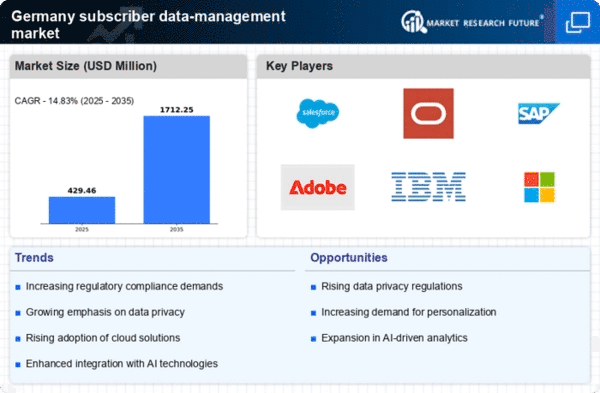Regulatory Compliance Pressures
In Germany, the subscriber data-management market is significantly influenced by stringent regulatory frameworks, particularly the General Data Protection Regulation (GDPR). Compliance with these regulations is not merely a legal obligation but also a competitive necessity. Organizations are compelled to invest in robust data management systems to ensure they handle subscriber information responsibly and transparently. Failure to comply can result in hefty fines, which can reach up to €20 million or 4% of annual global turnover, whichever is higher. This regulatory landscape is driving companies to adopt comprehensive data management strategies, thereby fostering growth in the subscriber data-management market as businesses seek to mitigate risks associated with non-compliance.
Growing Demand for Personalization
The subscriber data-management market in Germany is experiencing a notable surge in demand. Businesses are increasingly recognizing the importance of personalized customer experiences. Businesses are increasingly recognizing that tailored communications can enhance customer engagement and loyalty. According to recent studies, companies that leverage data-driven personalization strategies can see conversion rates increase by up to 20%. This trend is particularly pronounced in sectors such as retail and telecommunications, where understanding subscriber preferences is crucial. As organizations strive to differentiate themselves in a competitive landscape, the ability to effectively manage and analyze subscriber data becomes paramount. This growing emphasis on personalization is likely to drive investments in advanced data management solutions, thereby propelling the subscriber data-management market forward.
Increased Investment in Customer Experience
In Germany, there is a marked increase in investment aimed at enhancing customer experience, which directly influences the subscriber data-management market. Companies are recognizing that a superior customer experience can lead to higher retention rates and increased revenue. As a result, organizations are allocating more resources to data management initiatives that facilitate a deeper understanding of subscriber behavior and preferences. This trend is particularly evident in the telecommunications and media sectors, where customer satisfaction is paramount. It is estimated that businesses focusing on customer experience can achieve revenue growth of up to 10% annually. Consequently, the subscriber data-management market is likely to benefit from this heightened focus on customer-centric strategies.
Technological Advancements in Data Management
The subscriber data-management market in Germany is being propelled by rapid technological advancements. Innovations in cloud computing, machine learning, and data analytics are enabling organizations to manage subscriber data more efficiently. Innovations in cloud computing, machine learning, and data analytics are enabling organizations to manage subscriber data more efficiently and effectively. For instance, the integration of artificial intelligence into data management systems allows for real-time data processing and insights generation, which can enhance decision-making processes. As businesses increasingly adopt these technologies, the market is expected to witness substantial growth. Reports indicate that the market for cloud-based data management solutions is projected to grow at a CAGR of 15% over the next five years, underscoring the transformative impact of technology on the subscriber data-management market.
Emergence of Subscription-Based Business Models
The rise of subscription-based business models in Germany is reshaping the landscape of the subscriber data-management market. As more companies adopt these models, the need for effective data management solutions becomes increasingly critical. Subscription services require ongoing engagement with subscribers, necessitating a robust understanding of customer preferences and behaviors. This shift is particularly evident in industries such as entertainment and software, where companies rely on subscriber data to tailor offerings and improve retention. The subscription economy is projected to grow by 20% annually, indicating a substantial opportunity for the subscriber data-management market to expand as businesses seek to optimize their subscriber interactions and enhance overall service delivery.

















Leave a Comment